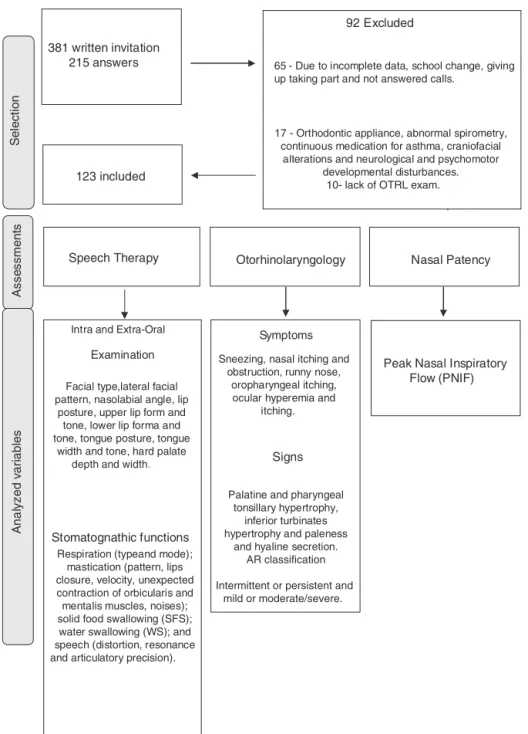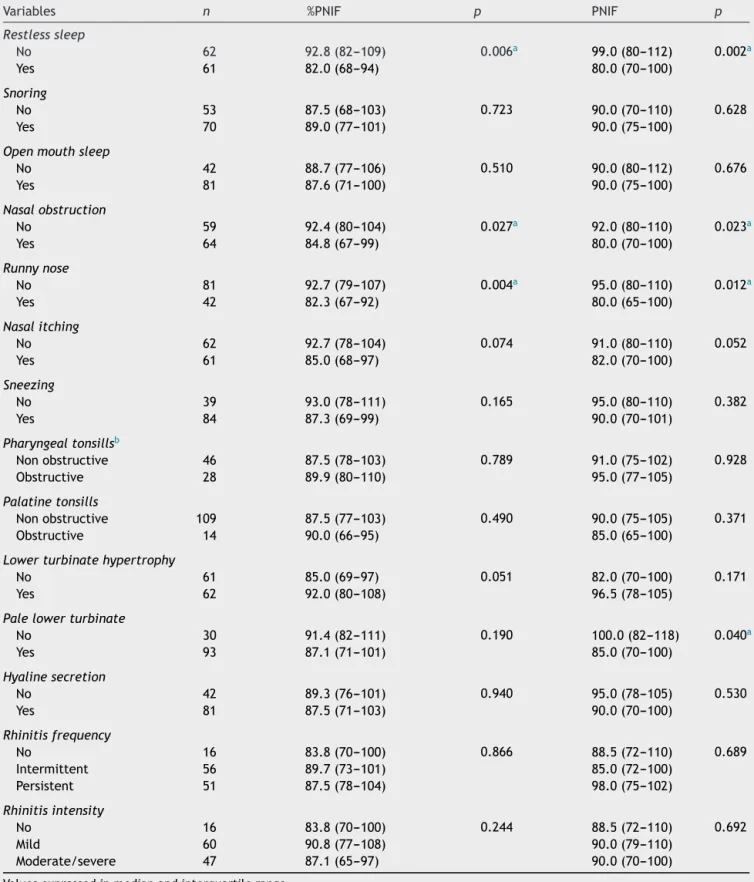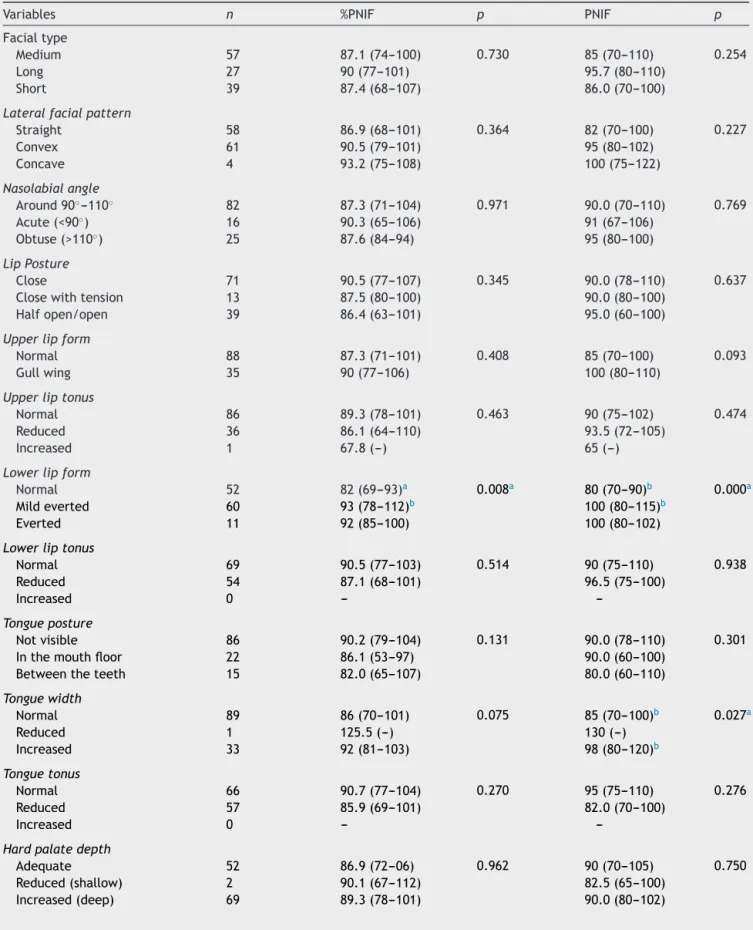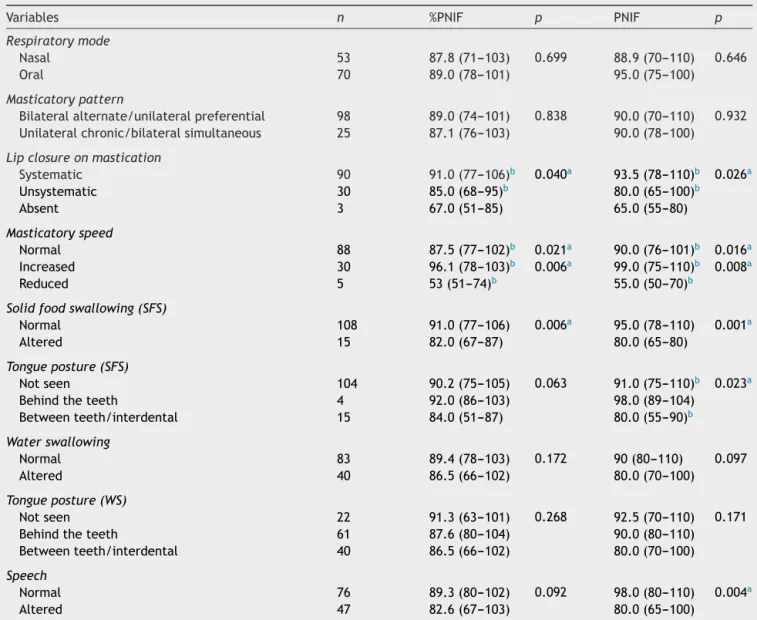www.bjorl.org
Brazilian
Journal
of
OTORHINOLARYNGOLOGY
ORIGINAL
ARTICLE
Nasal
patency
and
otorhinolaryngologic-orofacial
features
in
children
夽
Jovana
de
Moura
Milanesi
a,∗,
Luana
Cristina
Berwig
a,
Luiz
Henrique
Schuch
b,
Rodrigo
Agne
Ritzel
b,
Ana
Maria
Toniolo
da
Silva
c,
Eliane
Castilhos
Rodrigues
Corrêa
daUniversidadeFederaldeSantaMaria,ProgramadeDistúrbiosdeComunicac¸ãoHumana,SantaMaria,RS,Brazil bHospitalUniversitáriodeSantaMaria,SantaMaria,RS,Brazil
cUniversidadeFederaldeSantaMaria,DepartamentodeFonoaudiologia,SantaMaria,RS,Brazil dUniversidadeFederaldeSantaMaria,DepartamentodeFisioterapia,SantaMaria,RS,Brazil
Received13August2017;accepted27October2017 Availableonline21November2017
KEYWORDS
Nasalobstruction; Rhinitis;
Mouthbreathing; Stomatognathic diseases; Mastication
Abstract
Introduction:Nasalobstructionisacommonsymptominchildhood,relatedtorhinitisand pha-ryngealtonsilhypertrophy.Inthepresenceofnasalobstruction,nasalpatencymaybereduced, andnasalbreathingisreplacedbymouthbreathing.Orofacialandotorhinolaryngologicchanges arerelatedtothisbreathingmode.Objective evaluationofupperairwaysmaybeobtained throughnasalpatencymeasurement.
Objective: Tocomparenasalpatencyandotorhinolaryngologic-orofacialfeaturesinchildren. Methods:Onehundredandtwentythreechildren,6---12year-old,andofbothsexesunderwent speechtherapyevaluation,accordingtoOrofacialMyofunctionalEvaluationprotocol,clinical andendoscopicotorhinolaryngologicexaminationandnasalpatencymeasurement,usingthe absoluteandpredicted(%)peaknasalinspiratoryflowvalues.
Results:Lowervaluesofabsoluteandestimatedpeaknasalinspiratoryflowvalueswerefound inchildrenwithrestlesssleep(p=0.006andp=0.002),nasalobstructionreport(p=0.027and p=0.023), runnynose (p=0.004 and p=0.012),unsystematiclip closureduring mastication (p=0.040andp=0.026),masticatoryspeedreduced(p=0.006andp=0.008)andalteredsolid foodswallowing(p=0.006andp=0.001).Absolutepeaknasalinspiratoryflowwaslowerin chil-drenwithpaleinferiorturbinate(p=0.040),reducedhardpalatewidth(p=0.037)andaltered speech(p=0.004).Higherabsolutevalueswerefoundinchildrenwithincreasedtonguewidth (p=0.027)and,higherabsoluteandpredicted(%)inchildrenwithmildevertedlip(p=0.008 andp=0.000).
夽 Pleasecitethisarticleas:MilanesiJM,BerwigLC,SchuchLH,RitzelRA,SilvaAM,CorrêaEC.Nasalpatencyand otorhinolaryngologic-orofacialfeaturesinchildren.BrazJOtorhinolaryngol.2019;85:83---91.
∗Correspondingauthor.
E-mail:jovanamil@yahoo.com.br(J.M.Milanesi).
PeerReviewundertheresponsibilityofAssociac¸ãoBrasileiradeOtorrinolaringologiaeCirurgiaCérvico-Facial.
https://doi.org/10.1016/j.bjorl.2017.10.014
Conclusions:Nasalpatencywaslowerinchildrenwithrestlesssleep,rhinitissignsand symp-toms, hard palate width reduced andwith changes inmastication, deglutition and speech functions. Itisalso emphasized thatmostofthe children presentedsigns andsymptom of allergicrhinitis.
© 2017 Associac¸˜ao Brasileira de Otorrinolaringologia e Cirurgia C´ervico-Facial. Published by Elsevier Editora Ltda. This is an open access article under the CC BY license (http:// creativecommons.org/licenses/by/4.0/).
PALAVRAS-CHAVE
Obstruc¸ãonasal; Rinite;
Respirac¸ãooral; Doenc¸as
estomatognáticas; Mastigac¸ão
Patêncianasalecaracterísticasotorrinolaringológicaseorofaciaisemcrianc¸as
Resumo
Introduc¸ão:Aobstruc¸ãonasaléumsintomacomumnainfânciarelacionadoariniteehipertrofia dastonsilasfaríngeas.Napresenc¸adeobstruc¸ãonasal,apatêncianasalpodeestarreduzida e a respirac¸ão nasal ser substituída por respirac¸ão oral. Alterac¸ões orofaciais e otorrino-laringológicas estãorelacionadasa esse modo de respirac¸ão.A avaliac¸ão objetiva dasvias aéreassuperiorespodeserobtidaatravésdamedidadapatêncianasal.
Objetivo:Comparar apatêncianasal ecaracterísticas otorrinolaringológicaseorofaciais em crianc¸as.
Método: Foramsubmetidas123 crianc¸as deseis a12 anos,de ambosos sexos,a avaliac¸ão fonoaudiológica,deacordocomoprotocolodeavaliac¸ãoMiofuncionalOrofacial,exameclínico eendoscópicootorrinolaringológicoemedic¸ãodapatêncianasal,comousodopicodefluxo inspiratórionasalemvaloresabsolutosevaloresestimados(%picodefluxoinspiratórionasal). Resultados: Valoresmaisbaixosdepicodefluxoinspiratórionasale%picodefluxoinspiratório nasal foramencontradosem crianc¸as comsono agitado (p =0,006 e p =0,002),relato de obstruc¸ãonasal(p=0,027ep=0,023),rinorreia (p=0,004ep=0,012),fechamento não-sistemáticodoslábiosduranteamastigac¸ão(p=0,040ep=0,026),velocidademastigatória reduzida(p=0,006ep=0,008)ealterac¸ãodaingestãodealimentossólidos(p=0,006ep= 0,001).Opicodefluxoinspiratórionasalfoimenoremcrianc¸ascomconchasinferiorespálidas (p=0,040),reduc¸ãodalarguradopalatoduro(p=0,037)ealterac¸ões dafala(p=0,004). Valoresmaioresforamencontradosemcrianc¸ascomlarguradalínguaaumentada(p=0,027). Valoresmaioresdepicodefluxoinspiratórionasale%picodefluxoinspiratórionasalforam observadosemcrianc¸ascomlábiolevementeevertido(p=0,008ep=0,000).
Conclusões:A patêncianasalfoi menorem crianc¸ascomsonoagitado,sinaisesintomasde rinite,reduc¸ãodalarguradopalatoduroealterac¸õesnasfunc¸õesdemastigac¸ão,deglutic¸ão efala.Enfatiza-setambémqueamaioriadascrianc¸asapresentavasinaisesintomasderinite alérgica.
© 2017 Associac¸˜ao Brasileira de Otorrinolaringologia e Cirurgia C´ervico-Facial. Publicado por Elsevier Editora Ltda. Este ´e um artigo Open Access sob uma licenc¸a CC BY (http:// creativecommons.org/licenses/by/4.0/).
Introduction
Nasalobstructionisthemostcommonsymptominchildren andmayberelatedtopresenceofinflammatorynasal con-ditions asrhinitis and pharyngeal tonsil hypertrophy.1,2 In presenceof nasalobstruction, nasalbreathingis replaced by mouth breathing (MB).3---5 The upper airways may be evaluatedthroughnasalpatencymeasurement.PeakNasal InspiratoryFlow(PNIF) is anobjective, reliableand easy-to-use instrument for detection of obstructive and/or inflammatorynasalpatencydisorder,inclusiveinchildren.6,7 Thisinstrumenthasbeenusedinthenasalobstruction inten-sityandasatreatmentresultevaluationandfollow-up.1,8 Authors set reference values of PNIF for 8---15 year old Brazilian healthychildren.7 Therefore, besides the detec-tionofnasalpatencydisorder,itispossible toquantifyits
magnitudeandrelatesittoOtorhinolaryngologic(OTRL)and orofacialchanges.
thearcades,narrowanddeephardpalate,atypical deglu-titionandalterationsincraniofacialdevelopment,suchas increasedlowerthirdof theface.3,11---13 Itis believed that thesechangesarerelativetothenasalobstruction magni-tude, i.e., nasal patency intensity.Besides, the influence of etiological factor on MB consequences may be diverse andneedmoreinvestigation.Theaimofthisstudywasto compare nasal patency and otorhinolaryngologic-orofacial featuresin6---12yearoldchildren.
Methods
This prospective study has derived from a project titled ‘‘Integrated characterization and evaluation of orofacial motricityandbodyposturediseases---phaseII’’,approved inEthicsandResearchCommitteeofUniversidadeFederal deSantaMaria,underprotocol08105512.0.0000.5346with observationalandcross-sectionaldesign.
For this study, 6---12 year old children of both sexes wererecruited froman elementaryschool. Allparents or tutorswereinformedabouttheproceduresandsignedthe Consent Form,according to466/12 resolutionof National HealthCommittee(NHC). Childrenwithmissedor perma-nent dentition and normal ventilatory function, verified byspirometry,wereincluded. Spirometricevaluation(One Flow--- ClementClarke)wascarriedout,according tothe American Thoracic Society14 and Sociedade Brasileira de
Pneumologia e Tisiologia.15 Some exclusion criteria were established: signs and symptoms of rhinitis exacerbation, antihistaminicorcorticoidtherapyoralortopicduringthe last30days,undergoingorthodontictreatment, physiother-apy or speech therapy, with facial surgery or trauma or evident signs of neurological disease and/or craniofacial malformation(includingstomatognathicsystemalterations providedoftheseneurologicaldiseasesandmalformations). Childrenwithsignsandsymptomsofinfectiousrhinitisand otherstypesofrhinitiswerealsoexcluded.
All participants underwent speech therapy, OTRL and physicaltherapyassessmentsthroughevaluatorswithmore than5years’experienceandblindtoeachother.Selection andevaluationprocessesaredemonstratedinFig.1,aswell astheanalyzedvariables.
Stomatognathic system evaluation was carried out by an experienced speechtherapist inorofacial motricity by means of MBGR protocol.16 Masticatory, deglutition and speech functions were evaluated according to protocol instructions,Photographsandfilmingwerecarriedout.
Anotorhinolaryngologistevaluatedthechildren, consid-ering aspects such as palatine and pharyngeal tonsillary hypertrophy, nasal septum deviation and nasal mucosa edema, by means of oroscopy and anterior rhinoscopy. Nasoendoscopy or lateral cavum X-ray, depending on the childacceptance,asalsocarriedout.Palatineand pharyn-gealtonsilsassessmentsfollowed,respectively,accordingto BrodskyandKoch17andParikh18classifications.Additionally, the presence of rhinitis signs and symptoms were quali-tativelyanalyzed,suchas: inferiorturbinateshypertrophy andpaleness,hyalinesecretion,paroxysmalsneezing,nasal itchingandobstruction,runnynose,oropharyngealitching, ocular hyperemia and itching.9 For AR classification, the ARIA(AllergicRhinitisanditsImpact onAsthma)initiative
wasused,19relatedtothesymptomfrequency(intermittent orpersistent)andintensity(mildormoderate/severe).
PNIF measure was used for objective nasal patency assessment.Itwasevaluatedbyaphysical therapistusing theInCheckInspiratoryFlowMeter(ClementClarke Inter-national,theUnitedKingdom),fromresidualvolume(RV), i.e.,acompleteexpirationfollowedbyanasaldeep inspira-tionasfastandstrongaspossible,withmouthclosedanda well-adaptedmasktoface.Thehighestvalueobtainedfrom threerepetitionswasrecorded.20Theobtainedvalueswere transformedinpercentageofpredictedvaluesofPNIF,set byIbiapinaetal.,7accordingtosexandstature.
The STATISTICA 9.1 software (Statistica for Windows ---release9.1StatSoft)wasusedfordescriptiveandinferential dataanalysis,consideringp<0.05assignificantlevel.Data wereexposedinmedian andinterquartilerange.Lilliefors test was used for data normality analysis. Nasal patency valueswerecomparedtootorhinolaryngologic-orofacial fea-tures through Mann---Whitney, Kruskal---Wallis and Multiple ComparisonsTests.
Results
Thisstudyanalyzednasalpatencyand otorhinolaryngologic-orofacial features, comparing normal and altered condi-tions, in 123 children, 69 boysand 54 girls, mean age of 8.5±1.6yearsold.
Table 1 shows the %PNIF, PNIF values (predicted and absolute)anddatafromanamnesisandOTRLexamination. SignificantlowervaluesofPNIFand%PNIFwerefoundin chil-drenwithrestlesssleep,nasalobstructionreportandrunny nose.Significant lowerPNIF in childrenwith paleinferior turbinatewasalsofound.
InTable2PNIFand%PNIFvaluesaredescribed, compar-ingthemtostomatognathicvariablesrelatedtostructures evaluatedbyMBGRprotocol,withsignificant differencein lowerlipform,tongueandhardpalatewidth.
ComparisonbetweenPNIFand%PNIFvalueswith varia-bles related to stomatognathic functions, evaluated by MBGRprotocol,isshown inTable3.Significantlydifferent valueswerefoundinmastication,solidfoodswallowingand speechfunctions.
Discussion
Sel
ect
ion
381 written invitation
215 answers 65 - Due to incomplete data, school change, giving up taking part and not answered calls.
17 - Orthodontic appliance, abnormal spirometry, continuous medication for asthma, craniofacial
alterations and neurological and psychomotor developmental disturbances.
10- lack of OTRL exam.
.
A
ss
e
ss
me
n
ts
123 included
An
a
ly
z
e
d
v
a
ri
a
b
le
s
Speech Therapy
Examination
Facial type,lateral facial pattern, nasolabial angle, lip
posture, upper lip form and tone, lower lip forma and tone, tongue posture, tongue
width and tone, hard palate depth and width.
Stomatognathic functions Respiration (typeand mode);
mastication (pattern, lips closure, velocity, unexpected contraction of orbicularis and mentalis muscles, noises); solid food swallowing (SFS); water swallowing (WS); and speech (distortion, resonance and articulatory precision).
Symptoms
Sneezing, nasal itching and obstruction, runny nose,
oropharyngeal itching, ocular hyperemia and
itching.
Signs
Palatine and pharyngeal tonsillary hypertrophy,
inferior turbinates hypertrophy and paleness
and hyaline secretion. AR classification
Intermittent or persistent and mild or moderate/severe.
Peak Nasal Inspiratory Flow (PNIF) Otorhinolaryngology Nasal Patency
92 Excluded
Intra and Extra-Oral
Figure1 Flowchartofselection,evaluationproceduresandanalyzedvariables.
withhigh risk for sleep disorder, compared to low risk.23 Forty-three percent of sleep-disordered breathing symp-toms were found in 65 symptomatic children with nasal obstruction.24
This sample shows that children with nasal obstruc-tion report presented reduction of 7.6L/min in the PNIF value. These results demonstrate an association between symptomic and the objective measure of nasal patency. Nasal obstruction is the main symptom of rhinitis and it may be attributed to nasal mucosa inflammation and increased secretion.8 PNIF has been strongly associated withrhinitis,diagnosedthroughanteriorrhinoscopy.25 Fur-thermore, authors have demonstrated good correlation betweenPNIFandclinicalscoresofnasalobstruction.8,20,26 It must be emphasized that only clinical evaluation may
be insufficient at detecting nasal obstruction, once the obstruction detected through objective examination may bedifferentthat theonereportedbychildren, i.e.,their perceptionmaybeunderestimatedoroverestimated.8,24,26 Additionally,informationprovidedbyPNIFisdifferentfrom qualitativesymptomreports.25Therefore,acombinationof objectiveandsubjectivemethodsofnasalpatency assess-mentsissuggested.20,25,27
Table1 PNIF(predictedandabsolutevalues)anddatafromanamnesisandOTRLexamination.
Variables n %PNIF p PNIF p
Restlesssleep
No 62 92.8(82---109) 0.006a 99.0(80---112) 0.002a
Yes 61 82.0(68---94) 80.0(70---100)
Snoring
No 53 87.5(68---103) 0.723 90.0(70---110) 0.628
Yes 70 89.0(77---101) 90.0(75---100)
Openmouthsleep
No 42 88.7(77---106) 0.510 90.0(80---112) 0.676
Yes 81 87.6(71---100) 90.0(75---100)
Nasalobstruction
No 59 92.4(80---104) 0.027a 92.0(80---110) 0.023a
Yes 64 84.8(67---99) 80.0(70---100)
Runnynose
No 81 92.7(79---107) 0.004a 95.0(80---110) 0.012a
Yes 42 82.3(67---92) 80.0(65---100)
Nasalitching
No 62 92.7(78---104) 0.074 91.0(80---110) 0.052
Yes 61 85.0(68---97) 82.0(70---100)
Sneezing
No 39 93.0(78---111) 0.165 95.0(80---110) 0.382
Yes 84 87.3(69---99) 90.0(70---101)
Pharyngealtonsillsb
Nonobstructive 46 87.5(78---103) 0.789 91.0(75---102) 0.928 Obstructive 28 89.9(80---110) 95.0(77---105)
Palatinetonsills
Nonobstructive 109 87.5(77---103) 0.490 90.0(75---105) 0.371
Obstructive 14 90.0(66---95) 85.0(65---100)
Lowerturbinatehypertrophy
No 61 85.0(69---97) 0.051 82.0(70---100) 0.171
Yes 62 92.0(80---108) 96.5(78---105)
Palelowerturbinate
No 30 91.4(82---111) 0.190 100.0(82---118) 0.040a
Yes 93 87.1(71---101) 85.0(70---100)
Hyalinesecretion
No 42 89.3(76---101) 0.940 95.0(78---105) 0.530
Yes 81 87.5(71---103) 90.0(70---100)
Rhinitisfrequency
No 16 83.8(70---100) 0.866 88.5(72---110) 0.689
Intermittent 56 89.7(73---101) 85.0(72---100)
Persistent 51 87.5(78---104) 98.0(75---102)
Rhinitisintensity
No 16 83.8(70---100) 0.244 88.5(72---110) 0.692
Mild 60 90.8(77---108) 90.0(79---110)
Moderate/severe 47 87.1(65---97) 90.0(70---100)
Valuesexpressedinmedianandinterquartilerange.
%PNIF,PredictedPeakNasalInspiratoryFlow;PNIF,PeakNasalInspiratoryFlow(L/min);OTRL,Otorhinolaryngologic.
Table2 PNIF(predictedandabsolutevalues)andstomatognathicstructures(MBGRprotocol).
Variables n %PNIF p PNIF p
Facialtype
Medium 57 87.1(74---100) 0.730 85(70---110) 0.254
Long 27 90(77---101) 95.7(80---110)
Short 39 87.4(68---107) 86.0(70---100)
Lateralfacialpattern
Straight 58 86.9(68---101) 0.364 82(70---100) 0.227
Convex 61 90.5(79---101) 95(80---102)
Concave 4 93.2(75---108) 100(75---122)
Nasolabialangle
Around90◦---110◦ 82 87.3(71---104) 0.971 90.0(70---110) 0.769
Acute(<90◦) 16 90.3(65---106) 91(67---106)
Obtuse(>110◦) 25 87.6(84---94) 95(80---100)
LipPosture
Close 71 90.5(77---107) 0.345 90.0(78---110) 0.637
Closewithtension 13 87.5(80---100) 90.0(80---100)
Halfopen/open 39 86.4(63---101) 95.0(60---100)
Upperlipform
Normal 88 87.3(71---101) 0.408 85(70---100) 0.093
Gullwing 35 90(77---106) 100(80---110)
Upperliptonus
Normal 86 89.3(78---101) 0.463 90(75---102) 0.474
Reduced 36 86.1(64---110) 93.5(72---105)
Increased 1 67.8(---) 65(---)
Lowerlipform
Normal 52 82(69---93)a 0.008a 80(70---90)b 0.000a
Mildeverted 60 93(78---112)b 100(80---115)b
Everted 11 92(85---100) 100(80---102)
Lowerliptonus
Normal 69 90.5(77---103) 0.514 90(75---110) 0.938
Reduced 54 87.1(68---101) 96.5(75---100)
Increased 0 ---
---Tongueposture
Notvisible 86 90.2(79---104) 0.131 90.0(78---110) 0.301 Inthemouthfloor 22 86.1(53---97) 90.0(60---100)
Betweentheteeth 15 82.0(65---107) 80.0(60---110)
Tonguewidth
Normal 89 86(70---101) 0.075 85(70---100)b 0.027a
Reduced 1 125.5(---) 130(---)
Increased 33 92(81---103) 98(80---120)b
Tonguetonus
Normal 66 90.7(77---104) 0.270 95(75---110) 0.276
Reduced 57 85.9(69---101) 82.0(70---100)
Increased 0 ---
---Hardpalatedepth
Adequate 52 86.9(72---06) 0.962 90(70---105) 0.750 Reduced(shallow) 2 90.1(67---112) 82.5(65---100)
Table2 (Continued)
Variables n %PNIF p PNIF p
Hardpalatewidth
Adequate 77 90.7(79---107) 0.080 95.0(80---100)b 0.037a
Increased(wide) 2 90.1(67---112) 82.5(65---100) Reduced(narrow) 44 84.5(67---96) 80(67---100)b
Valuesexpressedinmedianandinterquartilerange.
%PNIF,Predicted PeakNasalInspiratoryFlow;PNIF,PeakNasalInspiratory Flow(L/min);MBGR,Marchesan, Berretin-Felix,Genaro, Rheder.
a Kruskal---WallisANOVA;Mann---WhitneyTest;p<0.05. b Categorieswithstatisticdifference.
Table3 PNIF(predictedandabsolutevalues)andstomatognathicfunctions(MBGRprotocol).
Variables n %PNIF p PNIF p
Respiratorymode
Nasal 53 87.8(71---103) 0.699 88.9(70---110) 0.646
Oral 70 89.0(78---101) 95.0(75---100)
Masticatorypattern
Bilateralalternate/unilateralpreferential 98 89.0(74---101) 0.838 90.0(70---110) 0.932 Unilateralchronic/bilateralsimultaneous 25 87.1(76---103) 90.0(78---100)
Lipclosureonmastication
Systematic 90 91.0(77---106)b 0.040a 93.5(78---110)b 0.026a
Unsystematic 30 85.0(68---95)b 80.0(65---100)b
Absent 3 67.0(51---85) 65.0(55---80)
Masticatoryspeed
Normal 88 87.5(77---102)b 0.021a 90.0(76---101)b 0.016a
Increased 30 96.1(78---103)b 0.006a 99.0(75---110)b 0.008a
Reduced 5 53(51---74)b 55.0(50---70)b
Solidfoodswallowing(SFS)
Normal 108 91.0(77---106) 0.006a 95.0(78---110) 0.001a
Altered 15 82.0(67---87) 80.0(65---80)
Tongueposture(SFS)
Notseen 104 90.2(75---105) 0.063 91.0(75---110)b 0.023a
Behindtheteeth 4 92.0(86---103) 98.0(89---104) Betweenteeth/interdental 15 84.0(51---87) 80.0(55---90)b
Waterswallowing
Normal 83 89.4(78---103) 0.172 90(80---110) 0.097
Altered 40 86.5(66---102) 80.0(70---100)
Tongueposture(WS)
Notseen 22 91.3(63---101) 0.268 92.5(70---110) 0.171 Behindtheteeth 61 87.6(80---104) 90.0(80---110) Betweenteeth/interdental 40 86.5(66---102) 80.0(70---100)
Speech
Normal 76 89.3(80---102) 0.092 98.0(80---110) 0.004a
Altered 47 82.6(67---103) 80.0(65---100)
Valuesexpressedinmedianandinterquartilerange.
%PNIF,Predicted PeakNasalInspiratoryFlow;PNIF,PeakNasalInspiratory Flow(L/min);MBGR,Marchesan, Berretin-Felix,Genaro, Rheder.
inboysand99.2L/miningirls.7Itwasobservedthatchildren inthisstudypresentedsimilarvaluestohealthychildren.
ConsequencesofMBmodehavebeenwidelystudiedfor thelastseveralyears.4,28---31Although,specificconsequences ofdecreasednasalpatencystillremaininconsistent.Results of stomatognathic system structures were rather varied. Unexpectedly, higher PNIF values were found in children withmild eversion lower lip and increasedtongue width. DecreasedPNIFvalueswerefoundinchildrenwithnarrower palate.TherewerenodifferencesinPNIFvaluesrelatedto stomatognaticsystemstructures.
Absence of lip sealing and interposition of tongue betweenteethandhardpalateatresiawerefound in chil-dren with adenotonsillar hypertrophy.30 Meanwhile,these changes that characterize MB may not be related to increasednasal resistance or reduced nasal airflow,32 but theymaybeduetooralhabits.
Inthepresentstudy,childrenwithorwithoutchangesin orofacialstructurespresentedsimilarPNIFvaluestohealthy children.7SuchfindingsmaybeexplainedconsideringMBas aconsequenceoforalhabits10,33ortransientedemaofnasal mucosa.34
Concerningstomatognaticfunctions,%PNIFandPNIF val-ueswerestatisticallylowerinchildrenwithunsystematiclip closureduringmasticationandreducedmasticatoryspeed. Suchvaluesof%PNIFandPNIFwererespectively, 53%and 55L/min,lower thantheones found inhealthy children.7 AstudyhasdetectedMBmodeandchangesinmasticatory andswallowingfunctions in 30 allergicrhinitis children.13 Authors have also found significant correlations between increaseofnasalobstructionsignsandsymptomsscoresand thepresenceofmasticatoryandswallowingdysfunctions.
Coordination between breathing and mastication is a complexprocessandasbreathingisamorevitalfunction, masticatorymovement maybeinterruptedduringMB.35 In thepresent study,unsystematiclip closurewas found, as wellasinanotherstudy,withchildrenpresenting adenoton-sillaryhypertrophy.4Furthermore,mentalisandorbicularis oris tension and tongue interposition between teeth dur-ing swallowingmay occur, asa compensatory mechanism necessarytokeepfoodinsidethemouth.4
Reduced %PNIF and PNIF values were also observed in childrenwithsoliddeglutitionaltered.Smallerpharyngeal airway space, detected by means of teleradiographs in 7---11yearsoldchildrenwithatypicaldeglutitionwasfound, comparedtoacontrol groupand considering ageand sex variables.36
Children with speech disorders presented significant lowerPNIFvaluesthantheoneswithnormalspeech func-tion.The most commonspeechdisordersdescribed in MB are:forwardtongueduringlingualdentalphonemes; impre-cision inbilabial andfricative phonemes;and frontaland lateral lisp.37 Lower mandibular movement speed during speechwasfoundinrhinitischildren,comparedtoacontrol group, but withno statistical significance.38 According to theauthors,nasalobstructionwouldberelatedtomobility, tonusandposturealterationofphono-articulatoryorgans.
It seems that the stomatognatic functions are firstly changed and this could cause structural alterations over time.Thechangesassociatedwithdecreasednasalpatency werethosethatarealsoassociatedwithMB.Thisreinforces theneedtotreatnasalobstructionalongwithtreatmentof
stomatognaticfunctions.However,thefactthatthesample presentedalargenumberofchildrenwithsignsand symp-toms of allergic rhinitis associated with decreased nasal patency,dictatesthattheresultsshouldbeconsideredwith caution.
Despite the fact that orofacial evaluation has an observational and qualitative nature, some systematic and standardized protocols have been used, allowing the comparison among studies.16,30 Another fact being con-sidered refers to the volitional character of PNIF exam, mainlywithchildren.Therefore,itissuggestedthatfurther researchwithquantitativeanalysisintheorofacial motric-ityandconcerningmethodologicalaspectsofPNIFtest,be considered.
Itisrelevanttoconsiderthatnasalobstructionmaycause structural and functional stomagnathic changes, in order to compensate the airflow impairment, given that lower patency wasfound in children with masticatoryand deg-lutition dysfunction. In order not to be neglected, these functions demand more attention, since theyare neither easilyrealizedbychildrennorobservedbyparentsand pro-fessionals.
Conclusion
Nasal patency was lower in children with restless sleep, rhinitissignsandsymptoms,reducedhardpalatewidthand changesinmastication,deglutitionandspeechfunctions.It isalsoemphasizedthatmostofthechildrenpresentedsigns andsymptomofallergicrhinitis.
Conflicts
of
interest
Theauthorsdeclarenoconflictsofinterest.
References
1.FernandesSSC,AndradeCR, IbiapinaCC.Applicationofpeak nasalinspiratoryflowreferencevaluesintreatmentofallergic rhinitis.Rhinology.2014;52:133---6.
2.KaracaCT,TorosSZ,Nos¸eriH,Külekc¸iS,KalayckC,OysuC,etal. Roleofallergy inchildrenwithadenotonsillarhypertrophy.J CraniofacSurg.2012;23:e611---3.
3.FrancoLP,SoukiBQ, CheibPL,AbrãoM,PereiraTBJ,Becker HMG,etal.Aredistinctetiologiesofupperairwayobstruction inmouth-breathingchildrenassociatedwithdifferent cephalo-metricpatterns?IntJPediatrOtorhinolaryngol.2015;79:223---8. 4.SouzaJF, GrechiTH,Anselmo-LimaWT,TrawitzkiLVV,Valera FCP.Masticationanddeglutitionchangesinchildrenwith ton-sillarhypertrophy.BrazJOtorhinolaryngol.2013;79:424---8. 5.NagaiwaM,GunjigakeK, YamaguchiK. Theeffectof mouth
breathingonchewingefficiency.AngleOrthod.2016;86:227---34. 6.TeixeiraRU,ZappeliniCE,AlvesFS,CostaEA.Peaknasal inspira-toryflowevaluationasanobjectivemethodofmeasuringnasal airflow.BrazJOtorhinolaryngol.2011;77:473---80.
7.IbiapinaCC,AndradeCR,CamargosPAM,AlvimCG,CruzAA. Referencevaluesforpeaknasalinspiratoryflowinchildrenand adolescentsinBrazil.Rhinology.2011;49:304---8.
9.IbiapinaCC,Sarinho ESC,Camargos PAM, Andrade CR, Filho AASC.Rinitealérgica:aspectos epidemiológicos,diagnósticos eterapêuticos.JBrasPneumol.2008;34:230---40.
10.AbreuRR,RochaRL,LamounierJA,GuerraAFM.Etiology, clin-icalmanifestationsandconcurrentfindingsinmouth-breathing children.JPediatr.2008;84:529---35.
11.Berwig LC, Silva AM, Côrrea EC, Moraes AB, Montenegro MM, Ritzel RA. Hard palate dimensions in nasal and mouth breathers from different etiologies. J Soc Bras Fonoaudiol. 2011;23:308---14.
12.CattoniDM,FernandesFDM, DiFrancescoRC,LatorreMRDO. Quantitativeevaluationoftheorofacialmorphology: anthropo-metricmeasurementsinhealthyandmouth-breathingchildren. IntJOrofacMyol.2009;35:44---54.
13.LemosCM,WilhelmsenNSW,MionOG,JúniorJFM.Functional alterations of the stomatognathic system in patients with allergicrhinitis:case---controlstudy.Braz JOtorhinolaryngol. 2009;75:268---74.
14.AmericanThoracicSociety.Lungfunctiontesting:selectionof referencevaluesandinterpretativestrategies.AmRevRespir Dis.1991;144:1202---18.
15.Sociedade Brasileira de Pneumologia e Tisiologia. Dire-trizes para testes de func¸ão pulmonar. J Bras Pneumol. 2002;28:S1---238.
16.MarchesanIQ,Berretin-FélixG,Genaro KF.MBGRprotocolof orofacialmyofunctionalevaluationwithscores.IntJOrofacial Myology.2012;38:38---77.
17.BrodskyL,KochRJ.Anatomiccorrelatesofnormalanddiseased adenoidsinchildren.Laryngoscope.1992;102:1268---74. 18.ParikhSR,CoronelM,LeeJJ,BrownSM.Validationofa new
gradingsystemforendoscopicexaminationofadenoid hyper-trophy.OtolaryngolHeadNeckSurg.2006;135:684---7. 19.BousquetJ, KhaltaevN,Cruz AA, DenburgWJ, FokkensWJ,
TogiasA,etal.AllergicRhinitisanditsImpactonAsthma(ARIA) 2008update(incollaborationwiththeWorldHealth Organiza-tion,GA(2)LENandAllerGen).Allergy.2008;63:8---160. 20.Trevisan MA, Bellinaso JH, Pacheco AB, Augé LB, Silva AM,
Corrêa ECR. Respiratory mode, nasal patency and palatine dimensios.CoDAS.2015;27:201---6.
21.OttavianoG, FokkensW. Measurements of nasal airflowand patency:acriticalreviewwithemphasisontheuseofpeaknasal inspiratoryflowindailypractice.Allergy.2016;71:162---74. 22.Chaves C, Ibiapina CC, Andrade CR, Godinho R, Alvim CG,
CruzAA.Correlationbetweenpeaknasalinspiratoryflowand peak expiratoryflow in childrenand adolescents. Rhinology. 2012;50:381---5.
23.KatyalV,PamulaY,DaynesCN,MartinJ,DreyerCW,Kennedy D,et al.Craniofacial and upper airway morphologyin pedi-atricsleep-disorderedbreathingandchangesinqualityoflife withrapidmaxillaryexpansion.AmJOrthodDentofacOrthop. 2013;144:860---71.
24.IsaacA, Major M,Witmans M,Alrajhi Y, Flores-Mir C,Major P,etal.Correlationsbetweenacousticrhinometry,subjective symptoms, and endoscopic findings in symptomatic children with nasal obstruction. JAMA Otolaryngol Head Neck Surg. 2015;141:550---5.
25.Starling-SchwanzR,PeakeRHL,SalomeCM,ToelleBG,NgKW, Marks GB,et al.Repeatabilityofpeak nasal inspiratory flow measurementsandutilityforassessingtheseverityofrhinitis. Allergy.2005;60:795---800.
26.GomesDL,CamargosPA,IbiapinaCC,AndradeCR.Nasalpeak inspiratoryflowandclinicalscoreinchildrenandadolescents withallergicrhinitis.Rhinology.2008;46:276---80.
27.MeloDL,SantosRVM,PeriloTVC,BeckerHMG,MottaAR.Mouth breathingevaluation:useofGlatzelmirrorandpeaknasal inspi-ratoryflow.CoDAS.2013;25:236---41.
28.Vilas-BoasAPD,MarsonFAL,RibeiroMAGO,SakanoE,ContiPBM, ToroADC,etal.Walktestand schoolperformancein mouth-breathingchildren.BrazJOtorhinolaryngol.2013;79:212---8. 29.LeeSY,GuilleminaultC,ChiuHY,SullivanSS.Mouthbreathing,
‘‘nasaldisuse’’andpediatricsleep-disorderedbreathing.Sleep Breath.2015;19:1257---64.
30.BuenoDA,Grechi TH,TrawitzkiLVV, Anselmo-LimaWT, Felí-cioCM,ValeraFCP.Muscularandfunctionalchangesfollowing adenotonsillectomyinchildren.IntJPediatOtorhinolaryngol. 2015;79:537---40.
31.CostaECJr,SabinoHAC,MiuraCS,AzevedoCB,MenezezUP, Valera FCP, et al. Atopy and adenotonsillar hypertrophy in mouthbreathersfromareferencecenter.BrazJ Otorhilolaryn-gol.2013;79:663---7.
32.FujimotoS, YamaguchiK, GunjigakeF.Clinicalestimationof mouth breathing. Am J Orthod Dentofac Orthop. 2009;136, 630e1---e6307.
33.NihiVS,MacielSM,JarrusME,NihiFM,SallesCL,PascottoRC, etal.Pacifier-suckinghabitdurationandfrequencyonocclusal andmyofunctionalalterationsinpreschoolchildren.BrazOral Res.2015;29:1---7.
34.TrevisanME,BoufleurJ,SoaresJC,HaygertCJ,RiesLGK,Corrêa ECR.Diaphragmaticamplitudeandaccessoryinspiratorymuscle activityinnasalandmouth-breathingadults:across-sectional study.JElectromyogrKinesiol.2015;25:463---8.
35.IkenagaN,YamaguchiK,DaimonS.Effectofmouthbreathingon masticatorymuscleactivityduringchewingfood.JOralRehabil. 2013;40:429---35.
36.JúniorJM,CrespoAN.Cephalometricevaluationofthe oropha-ryngeal space in children with atypical deglutition. Braz J Otorhinolaryngol.2012;78:120---5.
37.Hitos SF, Arakaki R, Solé D, WeckxLLM. Oral breathing and speechdisordersinchildren.JPediatr.2013;89:361---5. 38.LimaSJH,PernambucoLA,LinsAL,AlbuquerqueLCA,SilvaHJ.



